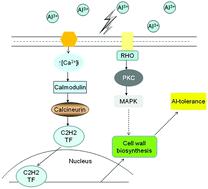当前位置:
X-MOL 学术
›
Metallomics
›
论文详情
Our official English website, www.x-mol.net, welcomes your
feedback! (Note: you will need to create a separate account there.)
Transcriptome analysis of Cryptococcus humicola under aluminum stress revealed the potential role of the cell wall in aluminum tolerance.
Metallomics ( IF 2.9 ) Pub Date : 2020-06-22 , DOI: 10.1039/d0mt00042f Mengyao Dai 1 , Jia Liu 1 , Lei Zhang 1 , Yong Tan 1 , Jinping Yan 1 , Juyuan Wang 2 , Hongjuan Nian 1
Metallomics ( IF 2.9 ) Pub Date : 2020-06-22 , DOI: 10.1039/d0mt00042f Mengyao Dai 1 , Jia Liu 1 , Lei Zhang 1 , Yong Tan 1 , Jinping Yan 1 , Juyuan Wang 2 , Hongjuan Nian 1
Affiliation

|
Aluminum (Al) toxicity is one of the most important limiting factors for crop yield in acidic soils. Bound Al gets converted into a toxic ionic state (Al3+) in acidic soil. Recent studies have shown that Al can act on the cell walls, cell membranes, organelles, and nuclei of microorganisms and affect substance and energy metabolism. To explore the gene expression at the transcriptional level under Al stress, we sequenced the transcriptome of Cryptococcus humicola, which is a highly Al-resistant yeast strain isolated from acidic soil and tolerates up to 200 mM Al3+. The screening conditions for genes from the control and experimental group were a false discovery rate (FDR) <0.05 and log 2|FC| > 1. A total of 4760 genes were differentially expressed, among which 3066 were upregulated and 1694 were downregulated. These genes control glycometabolism, protein synthesis, lipid metabolism and signalling pathways. Eleven selected differentially expressed genes were further validated using qRT-PCR. The results suggested that Al stress leads to complex responses in C. humicola. The effects of Al on the β-D-glucan and mannose contents and Al accumulation in the cell wall were determined. With an increase in the Al treatment time and concentration, the contents of β-D-glucan and mannose showed a trend of first increasing and then decreasing. Under Al treatment, the Al content of the cell wall also showed a trend of first increasing and then decreasing. These results suggested that Al accumulates in the cell wall and the cell wall plays a vital role in the Al resistance of C. humicola. The differentially expressed genes provide a foundation for the further study of Al tolerance in C. humicola.
中文翻译:

铝胁迫下腐殖质隐球菌的转录组分析揭示了细胞壁在铝耐受性中的潜在作用。
铝 (Al) 毒性是酸性土壤中作物产量的最重要限制因素之一。结合的铝在酸性土壤中会转化为有毒的离子态 (Al 3+ )。最近的研究表明,铝可以作用于微生物的细胞壁、细胞膜、细胞器和细胞核,影响物质和能量代谢。为了探索 Al 胁迫下转录水平的基因表达,我们对Cryptococcus humicola的转录组进行了测序,Cryptococcus humicola是一种从酸性土壤中分离出来的高度抗 Al 酵母菌株,可耐受高达 200 mM Al 3+. 对照组和实验组基因的筛选条件为错误发现率 (FDR) <0.05 和 log 2|FC|。> 1. 共有4760个基因差异表达,其中上调3066个,下调1694个。这些基因控制糖代谢、蛋白质合成、脂质代谢和信号通路。使用 qRT-PCR 进一步验证了 11 个选择的差异表达基因。结果表明,铝胁迫导致C. humicola 的复杂反应。测定了Al对β- D-葡聚糖和甘露糖含量以及细胞壁中Al积累的影响。随着Al处理时间和浓度的增加,β- D的含量-葡聚糖和甘露糖呈先增加后减少的趋势。在Al处理下,细胞壁Al含量也呈现先增加后减少的趋势。这些结果表明Al在细胞壁中积累,细胞壁在C. humicola的Al抗性中起重要作用。差异表达基因为进一步研究腐殖质耐铝性奠定了基础。
更新日期:2020-06-22
中文翻译:

铝胁迫下腐殖质隐球菌的转录组分析揭示了细胞壁在铝耐受性中的潜在作用。
铝 (Al) 毒性是酸性土壤中作物产量的最重要限制因素之一。结合的铝在酸性土壤中会转化为有毒的离子态 (Al 3+ )。最近的研究表明,铝可以作用于微生物的细胞壁、细胞膜、细胞器和细胞核,影响物质和能量代谢。为了探索 Al 胁迫下转录水平的基因表达,我们对Cryptococcus humicola的转录组进行了测序,Cryptococcus humicola是一种从酸性土壤中分离出来的高度抗 Al 酵母菌株,可耐受高达 200 mM Al 3+. 对照组和实验组基因的筛选条件为错误发现率 (FDR) <0.05 和 log 2|FC|。> 1. 共有4760个基因差异表达,其中上调3066个,下调1694个。这些基因控制糖代谢、蛋白质合成、脂质代谢和信号通路。使用 qRT-PCR 进一步验证了 11 个选择的差异表达基因。结果表明,铝胁迫导致C. humicola 的复杂反应。测定了Al对β- D-葡聚糖和甘露糖含量以及细胞壁中Al积累的影响。随着Al处理时间和浓度的增加,β- D的含量-葡聚糖和甘露糖呈先增加后减少的趋势。在Al处理下,细胞壁Al含量也呈现先增加后减少的趋势。这些结果表明Al在细胞壁中积累,细胞壁在C. humicola的Al抗性中起重要作用。差异表达基因为进一步研究腐殖质耐铝性奠定了基础。











































 京公网安备 11010802027423号
京公网安备 11010802027423号